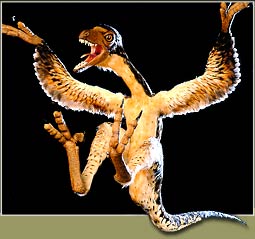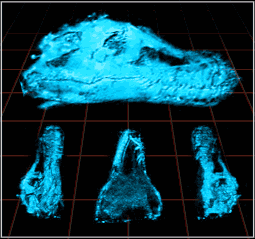 They had claws, teeth, and clout, so why would nonflying
theropods—meat-eating dinos—need feathers? (Some of the feathered dinosaurs
whose fossils were found in the 1990s may have been able to fly. Others, including the
skilled predator seen here, Sinornithosaurus millenii, couldn’t.)
They had claws, teeth, and clout, so why would nonflying
theropods—meat-eating dinos—need feathers? (Some of the feathered dinosaurs
whose fossils were found in the 1990s may have been able to fly. Others, including the
skilled predator seen here, Sinornithosaurus millenii, couldn’t.)
Feathers may have
helped the animals strut their stuff while wooing mates and challenging rivals—or
served as insulation. But only warm-blooded animals need insulation, so the feathers may
support those challenging the long-held belief that dinosaurs were cold-blooded.
 It couldn’t be done. Then Jeff Anders and Tom
Koehnlein did it—a CT scan of a Tyrannosaurus rex skull. The 2,000-pound
(908-kilogram) head belonging to Sue, the
It couldn’t be done. Then Jeff Anders and Tom
Koehnlein did it—a CT scan of a Tyrannosaurus rex skull. The 2,000-pound
(908-kilogram) head belonging to Sue, the
largest and most
complete T. rex ever found, would never fit on an ordinary medical scanner. So Sue
went to a Boeing lab in California, where the two engineers spent some 500 hours in 1998
x-raying coin-thin portions of the skull—slicing digitally instead of destructively.
“We’d never done anything like it before,” said Koehnlein. The result: new
insight into Sue’s senses.
 next
back
next
back
 They had claws, teeth, and clout, so why would nonflying
theropods—meat-eating dinos—need feathers? (Some of the feathered dinosaurs
whose fossils were found in the 1990s may have been able to fly. Others, including the
skilled predator seen here, Sinornithosaurus millenii, couldn’t.)
They had claws, teeth, and clout, so why would nonflying
theropods—meat-eating dinos—need feathers? (Some of the feathered dinosaurs
whose fossils were found in the 1990s may have been able to fly. Others, including the
skilled predator seen here, Sinornithosaurus millenii, couldn’t.)  It couldn’t be done. Then Jeff Anders and Tom
Koehnlein did it—a CT scan of a Tyrannosaurus rex skull. The 2,000-pound
(908-kilogram) head belonging to Sue, the
It couldn’t be done. Then Jeff Anders and Tom
Koehnlein did it—a CT scan of a Tyrannosaurus rex skull. The 2,000-pound
(908-kilogram) head belonging to Sue, the 